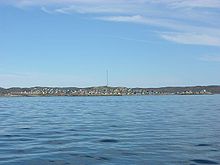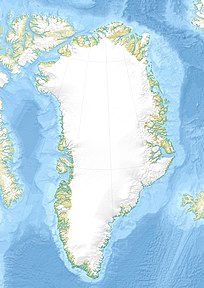Kangaatsiaq
| Kangaatsiaq (medium headland) | ||
|---|---|---|
| Kangâtsiaĸ | ||
| View of Kangaatsiaq | ||
| Commune | Qeqertalik municipality | |
| District | Kangaatsiaq | |
| Geographical location | 68 ° 18 '30 " N , 53 ° 27' 38" W | |
|
|
||
| Residents | 520 (January 1, 2020) |
|
| founding | around 1829 | |
| Time zone | UTC-3 | |
Kangaatsiaq [ kaˈŋaːt͡sːiɑq ] (according to the old spelling Kangâtsiaĸ ) is a Greenland city in the district of Kangaatsiaq in the municipality of Qeqertalik .
location
Kangaatsiaq is located on a headland that is part of the Kangaatsiap Nunaa peninsula . A strait separates the cape from the island of Inussulik . There are also several islands around the place, including Umiiarfik to the west and the islands of Qeqertannguaq and Qeqertannguup Ikkarlua in the northwest. The city is located at the far end of the fjord and archipelago system of the Kangaatsiaq archipelago. The next settlement is Ikerasaarsuk, 19 km south .
history
founding
Kangaatsiaq was not populated at the beginning of the colonial era. Instead, people had lived on the island of Inussulik for ages. These fell victim to the epidemic of 1785/86. The place then only served as a campground in summer. Later it was settled again permanently. In 1808 twelve people lived there. In 1821 there was a house with fourteen residents on the somewhat more distant island of Killiat , there were two houses in which 71 people lived. It is said that the one house that 52 people lived in was so big that you had to shout so that someone at the other end could hear you. In 1826/27 the colonial administrator Johan Lorentz Mørch drove yarn fishing in Nassaaq, which was probably on the south bank of the island of Ippernat Nunaat, directly south of Kangaatsiaq. In 1829, both Inussulik and Killiat and Nassaaq were uninhabited. Instead, Kangaatsiaq was first mentioned, where 20 people lived. In 1831 the place already had 34 inhabitants. In 1840 Kangaatsiaq became an Udsted , which was initially only operated in winter. In 1846 Kangaatsiaq became Udsted all year round. In 1851 a house with a shop was built for the Udsteds administrator.
Kangaatsiaq is the place of origin of the Greenlandic Lundblad family.
Kangaatsiaq as Udsted
In 1915 there were 118 people living in 14 houses. The old apartment for the Udsteds administrator, which was built in 1851 as a half-timbered building with a half-height peat wall facade and roof shingles, was still standing. The shop was built in 1911 as a half-timbered building with wood paneling. There were also two bacon houses, one made of wood and the other of peat walls. The school chapel was built in 1870 and was a half-timbered building with a peat wall facade and roofing felt. Inside it was a harmonium that the population had paid for. In addition to 26 hunters and two fishermen, there was an Udsteds administrator, a midwife and a catechist in Kangaatsiaq. In 1920 a new school chapel was built. Later a new apartment for the Udsteds administrator and several fish houses were built. A school was built in 1939. In 1941 there were 176 people in Kangaatsiaq and in 1950 there were already 196. The population rose further to 266 people in 1960 and 371 in 1970.
Kangaatsiaq was a separate community in the colonial district of Egedesminde until 1950 , to which the residential areas Qeqertarsuatsiaq , Akulliit , Innalik and Qipingasoq belonged. The municipality was in the 2nd district of North Greenland. Kangaatsiaq belonged to the parish of Aasiaat and was part of the second southernmost upper catechetical district of the parish.
Kangaatsiaq as a parish seat and city
In 1950, Kangaatsiaq, which was not a colony until then, was made the seat of the new Kangaatsiaq community as part of the administrative reform . Because the place was previously only an Udsted, the place was for a long time the only municipal seat in Greenland without city rights. These were finally awarded in 1986, making Kangaatsiaq the youngest city in Greenland. Nevertheless, before and after, the church functioned as part of the Aasiaat municipality , as many municipal functions were to be found in Aasiaat . Already in the 1960s it was considered to depopulate the entire community, but this did not happen.
economy
The people of Kangaatsiaq mainly work in administration, services and trade, and to a lesser extent in fishing. Royal Greenland operates a fish factory in Kangaatsiaq that freezes sea hare , striped sea wolf and cod and processes them into dried fish . Tourism is another important economic sector in the town. For example, dog sledding tours and whale watching are offered; Northern lights can also be viewed.
Infrastructure and supply
Kangaatsiaq has relatively few streets and paths for a city. In winter, inner-city traffic runs on dog sleds and snowmobiles . There is a flight connection to Aasiaat from November to April via the Kangaatsiaq heliport . From May to December, the place can be approached by sea, while the rest of the year the ice conditions determine the accessibility. The port consists of a twelve meter long quay on a three meter deep harbor basin.
Nukissiorfiit is responsible for the electricity, water and heating supply. Electricity is provided by a diesel power plant. Fresh water is drawn from two nearby lakes. Waste is dumped and incinerated. Most of the buildings in Kangaatsiaq are not connected to a sewage system. TELE Greenland enables the telecommunication connection from Kangaatsiaq.
Development
Kangaatsiaq's residents are supplied with goods from a Pilersuisoq branch. In the city there is a café, several places to stay for tourists, a meeting building, a football field and an infirmary with a dental practice and a nursing home. A leisure club is also attached to the kindergarten. The school houses a library and another leisure club. Kangaatsiaq is also the location of a vocational school.
Several buildings in Kangaatsiaq are protected.
Sons and daughters
- Johan Bidstrup (1867–1920), trade administrator and councilor
Population development
The population of Kangaatsiaq rose sharply until the mid-1990s, but has been falling again since the mid-2000s.

Web links
Individual evidence
- ↑ Map with all official place names confirmed by Oqaasileriffik , provided by Asiaq
- ^ A b c Hother Ostermann : Beskrivelse af Distrikterne i Nordgrønland: Egedesminde district. De grandson Bopladser. Udstedet Kangâtsiaĸ . In: Georg Carl Amdrup , Louis Bobé , Adolf Severin Jensen , Hans Peder Steensby (eds.): Grønland i tohundredeaaret for Hans Egedes landing (= Meddelelser om Grønland . Volume 60-61 ). tape 1 . C. A. Reitzel Boghandel, Copenhagen 1921, p. 73 ff . ( Digitized in the Internet Archive ).
- ↑ Jens Christian Madsen: Udsteder og bopladser i Grønland 1901-2000 . Atuagkat, 2009, ISBN 978-87-90133-76-4 , pp. 123 f .
- ↑ Kangaatsiaq vil nu have bystatus in the Atuagagdliutit of October 3, 1984
- ↑ a b c d Kangaatsiaq at qaasuitsup-kp.cowi.webhouse.dk
- ↑ Kangaatsiaq at groenlandkreuzfahrt.de
- ↑ Bør Kangâtsiaĸ commune nedlægges? in the Atuagagdliutit of July 30, 1964
- ↑ Population of Kangaatsiaq 1977–2020 at bank.stat.gl


